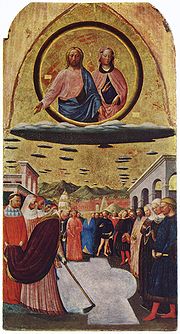- Dedication of Saint Mary Major
-
General articles
Overview of Mariology •
Veneration of the Blessed Virgin • History of MariologyExpressions of devotion
Art • Hymns • Music • ArchitectureSpecific articles
Apparitions • Saints • Popes • Societies • Hearts of Jesus & Mary • Consecration to MaryThe Dedication of Saint Mary Major, previously known as Dedicatio Sanctæ Mariæ ad Nives (Dedication of the Church of Our Lady of the Snows), is a liturgical feast day celebrated on August 5 in the Latin Rite of the Catholic Church. In the Roman Catholic calendar of saints it has the rank of optional memorial, and in the General Roman Calendar of 1962 it is third-class feast. It commemorates the dedication of the restored Basilica di Santa Maria Maggiore by Pope Sixtus III just after the First Council of Ephesus. This major basilica, located on the summit of the Esquiline Hill in Rome, is called the Basilica of Saint Mary Major (Latin: Basilica Sancta Mariæ Majoris) because it is the largest church in Rome dedicated to the Blessed Virgin Mary.
The church was originally built during the pontificate of Pope Liberius, and is thus sometimes known as the "Basilica Liberii" or "Basilica Liberiana".
History
Pope Pius V inserted this feast into the General Roman Calendar in 1568,[1] when, in response to the request of the Council of Trent, he reformed the Roman Breviary. Before that, it had been celebrated at first only in the church itself and, beginning in the fourteenth century, in all the churches of the city of Rome.[2]
It thus appears in the Tridentine Calendar for celebration as a Double. In Pope Clement VIII's Missal of 1604, it was given the newly invented rank of Greater Double. In Pope John XIII's classification it became a Third-Class Feast.[3] This 1960 calendar, included in the 1962 edition of the Roman Missal, is the calendar whose continued use privately and, under certain conditions, publicly is authorized by the motu proprio Summorum Pontificum. Nine years later, the celebration became an optional Memorial.[4]
Until 1969 the feast was known as Dedicatio Sanctæ Mariæ ad Nives (Dedication of the Church of Our Lady of the Snows), a name that had become popular for the Basilica in the fourteenth century[1] in connection with a legend about its origin that the Catholic Encyclopedia summarizes: "During the pontificate of Liberius, the Roman patrician John and his wife, who were without heirs, made a vow to donate their possessions to the Virgin Mary. They prayed that she might make known to them how they were to dispose of their property in her honour. On 5 August, at the height of the Roman summer, snow fell during the night on the summit of the Esquiline Hill. In obedience to a vision of the Virgin Mary which they had the same night, the couple built a basilica in honour of Mary on the very spot which was covered with snow. From the fact that no mention whatever is made of this alleged miracle until a few hundred years later, not even by Sixtus III in his eight-line dedicatory inscription ... it would seem that the legend has no historical basis."[2]
The Encyclopedia also informs that, in 1741, a congregation set up by Pope Benedict XIV proposed that the reading of the legend be removed from the Roman Breviary and that the original name, "Dedicatio Sanctæ Mariæ", be restored. This recommendation was implemented only in 1969.
References
- ^ a b Calendarium Romanum (Libreria Editrice Vaticana 1969), p. 99
- ^ a b
 "Our Lady of the Snow". Catholic Encyclopedia. New York: Robert Appleton Company. 1913.
"Our Lady of the Snow". Catholic Encyclopedia. New York: Robert Appleton Company. 1913. - ^ General Roman Calendar of 1962
- ^ Roman Catholic calendar of saints
External links
- "The Dedication of St. Mary ad Nives", Butler's Lives of the Saints
- Devotion to Our Lady of the Snows from the National Shrine of Our Lady of the Snows website of The Missionary Oblates of Mary Immaculate
Categories:- Catholic holy days
Wikimedia Foundation. 2010.


